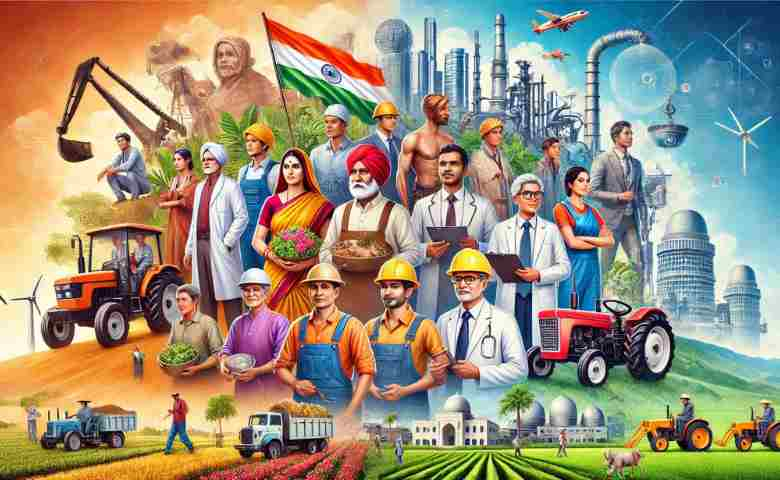Last Updated on August 8, 2024 by Admin
India’s labour market has experienced significant changes between 2017-18 and 2022-23, creating approximately 114 million jobs. However, the underlying issues, such as high unemployment rates among the educated, sluggish growth in salaried jobs, and a high dependency on the agricultural sector, remain pressing concerns. This post delves into these trends, the impact of government initiatives, and future projections to provide a comprehensive understanding of the current and future landscape of India’s labour market.
Table of Contents
Overview
India’s labour market has undergone significant changes between 2017-18 and 2022-23, as highlighted in a recent report by ICRA. During this period, the country created approximately 114 million jobs, reflecting a compound annual growth rate (CAGR) of 4.4%, which outpaced the population growth rate of 0.9%. This growth led to an improvement in the worker-population ratio (WPR) and a reduced unemployment rate. However, beneath these headline numbers lie several critical issues that must be addressed for sustained and inclusive economic growth.
Job Creation and Sectoral Distribution
A substantial portion of the job creation between 2017-18 and 2022-23 occurred in the agriculture sector, accounting for nearly 53% of the total jobs added. However, this sector experienced a decline in value-added per worker (VAPW), indicating a drop in labour productivity and an increase in disguised unemployment. This trend underscores the need for structural reforms to enhance productivity in agriculture and to facilitate the transition of excess labour to more productive non-agricultural sectors.
Practice 15+ AI-generated technical and HR interview questions for Civil, BIM, QS, Planning, HSE and Construction roles. Get instant feedback, improved answers, a 7-day improvement plan, and a full PDF report. Designed exclusively for construction professionals.
One free full interview session included. No credit card required.
Employment Types and Growth Rates
The report highlights a disparity in the growth rates of different types of employment. Regular or salaried jobs grew at a modest CAGR of 2.6%, while the self-employed segment saw a sharper increase of 6.4%, primarily driven by a rise in helpers in household enterprises. This trend suggests household stress and inadequate salaried job opportunities, pushing more individuals towards self-employment.
Unemployment Rates and Education
The unemployment rate declined from 6.1% in 2017-18 to 3.2% in 2022-23. However, the urban unemployment rate remained at 5.4%, compared to 2.4% in rural areas. Notably, unemployment was significantly higher among educated individuals, with a rate of 13.4% for graduates, compared to just 0.2% for illiterates. This disparity points to a mismatch between the skills of the educated workforce and the available job opportunities, emphasizing the need for better alignment between education and industry requirements.
Government Initiatives
To address these challenges, the Government of India (GoI) has launched several initiatives, including a three-part ‘Employment-Linked Incentive’ scheme and a skilling programme with a total outlay of Rs. 2.0 trillion over five years. These measures aim to boost job creation, enhance skill development, and improve the overall employment scenario in the country. Successful implementation of these schemes will be crucial in overcoming the current labour market issues.
Future Projections and Challenges
ICRA projects that India will need to create approximately 7.0 million non-agricultural jobs annually between 2024-25 and 2033-34 to accommodate the growing workforce and technological advancements like Artificial Intelligence (AI) and automation. Additionally, there is a pressing need to shift excess farm labour to non-farm jobs with higher VAPW to ensure sustainable economic growth.
Key Insights
- Job Creation: 114 million jobs created between 2017-18 and 2022-23, with a CAGR of 4.4%.
- Sectoral Contribution: Agriculture sector contributed 53% of the job creation, despite declining productivity.
- Employment Growth: Regular jobs grew at 2.6%, self-employment at 6.4%.
- Unemployment Rates: Overall rate at 3.2% in 2022-23; urban areas at 5.4%; graduates at 13.4%.
- Government Initiatives: Rs. 2.0 trillion allocated for employment-linked incentives and skilling programmes.
- Future Needs: 7.0 million non-agri jobs/year needed from 2024-25 to 2033-34.
Reliable Sources for Additional Information
For the most accurate and up-to-date information on India’s labour market and related government initiatives, the following sources are recommended:
- Periodic Labour Force Survey (PLFS) – Provides comprehensive data on employment, unemployment, and labour force participation in India. PLFS Report.
- Ministry of Labour & Employment, Government of India – Offers detailed insights into various employment schemes and initiatives. Ministry of Labour & Employment
- ICRA Limited – For detailed analytical reports and projections on the Indian economy and labour market. ICRA Reports.
The Takeaway
As India continues to navigate the complexities of its labour market, addressing the challenges of skill mismatch, job creation, and productivity will be crucial. The government’s recent initiatives are promising steps towards a more robust employment scenario. However, the execution of these schemes and the ability to adapt to technological advancements will determine the success of these efforts. By staying informed and proactive, India can create a more inclusive and dynamic labour market, fostering sustainable economic growth.
Related Posts:
- Current Scenario of the Indian Construction Industry in 2024
- The Ultimate Guide to Creating a Successful Business Plan
- The Impact of India’s Infrastructure Boom on Careers in Civil Engineering: A Future Laced With Opportunity
- Bridging the Gap: Addressing Unemployment Among Engineering Graduates in India
- Clean Energy and Job Creation: Opportunities for a Greener Economy


